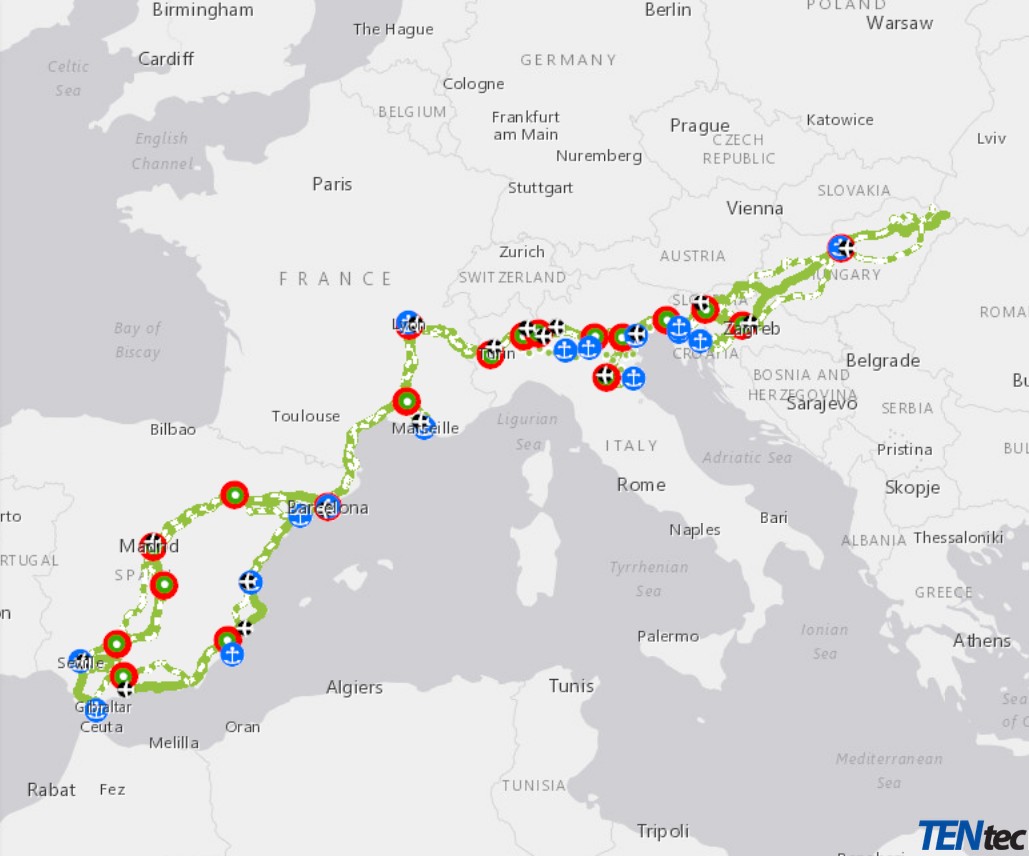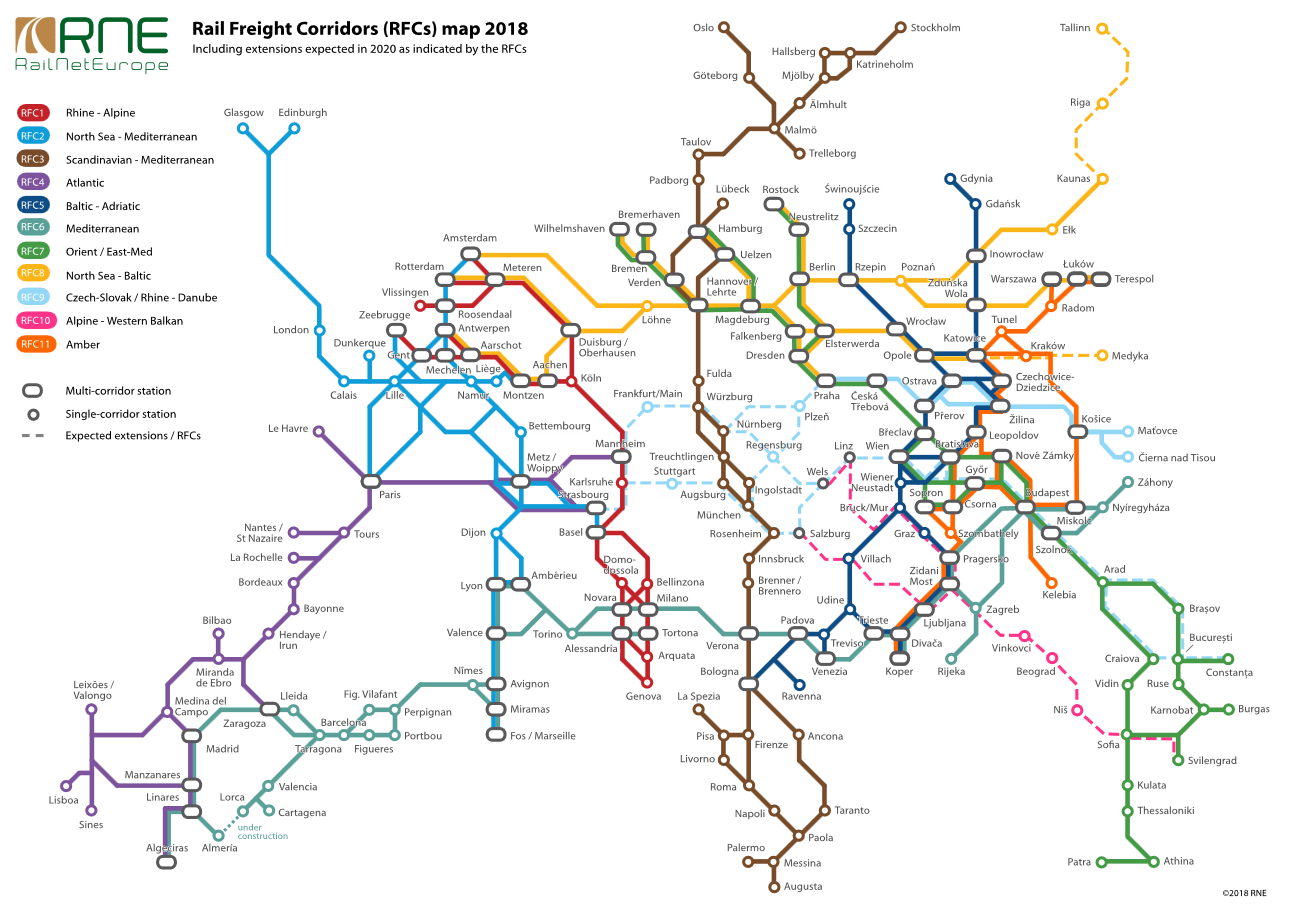Transport corridors
PORT OF RIJEKA IN THE TRANS-EUROPEAN TRANSPORT NETWORK
Port of Rijeka is connected to European transport road and railway corridors and common navigation and information systems. In addition to roads and railways, oil pipeline systems linking refineries in Croatia, Hungary, Austria, Bosnia and Herzegovina, Serbia, the Czech Republic and Slovakia are also regarded of great importance.
All transport corridors within the European Union belong to the unique Transeuropean Network (TEN-T), which includes 106,000 km of railway lines (32,000 km of high speed lines), 96,000 km of roads, 13,800 km of inland waterways, 411 airports , 300 river ports, and numerous traffic management systems and navigation and information systems.
The TEN-T network is being developed in line with the proposal of the Regulation of the EU Guidelines for the Development of the Trans-European Transport Network of 19 October 2011 and the Connecting Europe Facility (CEF) for Europe’s Connecting Europe Facility (CEF) by developing two networks.
The comprehensive network represents the general layer of TEN-T and includes all existing and planned infrastructure that meets the requirements of the Guidelines and should be established no later than 31 December 2050.
The core network includes only those parts of a comprehensive network that are strategically most significant and should be established by 31 December 2030 at the latest. The European Commission Decision of 18 October 2013 defined the nine Corridors of the EU Core Transport Network as the backbone for the merger of 94 major European ports and 38 key rail and road airports in the major cities of Europe (Luka Rijeka and Zagreb Airport are among them) and the development of 15 thousand kilometers of railway infrastructure capable of achieving satisfactory speeds for passenger and freight trains as well as 35 border transition.
PORT OF RIJEKA AMONG PRIORITIES OF EUROPEAN TRANSPORT POLICY
There are nine main transport networks: the Rhine-Alpine Corridor, the Corridor North Sea – the Mediterranean, the Scandinavian-Mediterranean corridor, the Atlantic Corridor, the Baltic-Adriatic Corridor, the Mediterranean Corridor, the Corridor Middle East, the Corridor North Sea – the Baltic, the Czech-Slovak Corridor.
Each of the corridors must include three types of transport infrastructure, pass through three member states and two border crossings. All nine corridors are the priority of the European Union’s transport policy, which is why an additional 26 billion Euro financial instrument called the Connecting Europe Facility (CEF) has been established.
LIST OF CORE EUROPEAN TRAFFIC CORRIDORS:
1. Rhine-alpine corridor, passing through the Netherlands, Belgium, Germany and Italy
2. Corridor North Sea – Mediterranean, passing through Holland, Belgium, Luxembourg and France
3. The Scandinavian-Mediterranean Corridor, which passes to Sweden, Denmark, Germany, Austria and Italy
4. Atlantic Corridor, which passes through Portugal, Spain and France
5. The Baltic – Adriatic Corridor, which passes to Poland, the Czech Republic, Slovakia, Austria, Italy and Slovenia
6. The Mediterranean Corridor, passing through Spain, France, Italy, Slovenia, Croatia and Hungary
7. Corridor The Middle East, which passes by Czech Republic, Austria, Slovakia, Hungary, Romania, Bulgaria and Greece
8. Corridor North Sea – The Baltic, which passes to Germany, the Netherlands, Belgium, Poland and Lithuania
9. Czech-Slovak Corridor, which passes between Czech and Slovak
EUROPEAN INFRASTRUCTURE PROJECTS OF THE PORT OF RIJEKA AUTHORITY
Port of Rijeka is a core port in the Trans-European Transport Network (TEN-T) Mediterranean Corridor, thus creating the basis for improving the hinterland connection, especially via the railways. This additionally has a positive impact on the development of port infrastructure and port modernization.
Therefore, the Port of Rijeka Authority has successfully withdrawn financial resources from the Connecting Europe Instrument for the purpose of improving the infrastructure of the port of Rijeka for a total of 7 projects, enhancing the port, railway and information and communication infrastructure.
The total value of the Port of Rijeka’s development projects co-financed by the CEF is EUR 133 million. The projects are related to the modernization of the railway infrastructure and the construction of new intermodal capacities in the port of Rijeka, the reconstruction of the dock for general cargo and the implementation of the Port Community system of the Port Community System. All projects will be realized in 2020 and 2021 respectively.
CEF LIST OF PROJECTS CO-FINANCED BY THE CEF PROGRAMME:
• Development of the multimodal platform in the Port of Rijeka and connection with the Adriatic Gate Container Terminal (POR2CORE-AGCT) open!
• Upgrade of the infrastructure in the Port of Rijeka – Port Community Information System (POR2CORE-PCS) open!
• Upgrade of the infrastructure in the Port of Rijeka – Zagreb Container Terminal (POR2CORE – ZCT) open!
• Upgrade of the infrastructure in the Port of Rijeka – Basin Rijeka (POR2CORE-Rijeka Basin) open!
• Upgrade of the infrastructure in the Port of Rijeka – Terminal for Bulk Cargo Bakar (POR2CORE-BCTB) open!
• Upgrade of the infrastructure in the Port of Rijeka – Terminal for General Cargo (POR2CORE-GCT) open!
• Upgrade of the infrastructure in the Port of Rijeka – Dredging at the AGCT open!
RAILWAY TRAFFIC CORRIDORS
In 2010, the European Parliament and the Council laid down rules for the establishment of a European rail network for competitive freight transport consisting of international freight corridors. The intention was to achieve reliable and quality freight services so that rail transport could compete with other types of transport.
To achieve these goals, the European Union has designated nine international freight corridors (RFCs) on the European Union’s rail network. European Rail Freight Corridors are abbreviated as RFC (full name Rail Freight Corridors)
Nine rail freight corridors have been put into operation in accordance with European Union (EU) Regulation no. 913/2010 on the European rail network for competitive freight traffic, which entered into force on 9 November 2010. This Regulation requires Member States to establish an international market-oriented rail freight corridor of RFCs to address the three major challenges:
Strengthen cooperation between infrastructure managers on key aspects such as route assignment, introduction of interoperable systems and infrastructure development finding the right balance between freight and passenger traffic along the RFC, providing adequate load capacity in accordance with market needs and ensuring that the common quality objectives are met for freight trains promoting intermodality between railway and other modes of transport by integrating the terminal into the corridor management process. Port of Rijeka is located on the RFC 6 freight corridor under the name of the Mediterranean Corridor, and in the immediate vicinity is the railway freight corridor of the Baltic Adriatic Corridor.
PORT OF RIJEKA AND MEDITERRANEAN CORRIDOR RFC 6
The Mediterranean Corridor RFC 6 is a total of about 7,000 kilometers long and connects the south of the Pyrenees Peninsula through the Spanish and French Mediterranean coasts, passes through the Alps in the north of Italy, then enters Slovenia and continues to the Hungarian-Ukrainian border. It passes through six states and connects 10 seaports and about 90 terminals. Its route covers the Rijeka railway and one of the historic and strategically important land routes of Rijeka to Hungary and Central Europe.
The Mediterranean corridor was extended to the Republic of Croatia on November 10, 2016 on the Rijeka – Zagreb – (Budapest) and Zagreb – (Ljubljana) routes, with the involvement of the Croatian railway infrastructure manager HŽ Infrastruktura. The involvement of the Republic of Croatia is an important event to create the basis for the future development of freight transport in the eastern part of the Mediterranean Corridor.
The Mediterranean Corridor for Railway Freight 6 (RFC 6) is aimed at achieving the following goals:
- Improving the commercial offer provided by the Mediterranean Corridor with meeting the capacity requirements in a short time
- Implementation of the process of coordination of temporary capacity constraints for the purpose of their optimization
Improving Infrastructure Standards - Strengthen the system of tracking key RFC 6 performance indicators that are aligned with all European corridors
- Train efficiency by eliminating technical and regulatory barriers that restrict the interoperability of trains, with the aim of ensuring better operational performance.
PORT OF RIJEKA AND THE VICINITY OF THE BALTIC ADRIATIC RAIL CORRIDOR RFC 5
The port of Rijeka is not located on this corridor although it is physically connected by the railway line Rijeka – Šapjane – Ilirska Bistrica – Pivka in the context of the new EU transport system. The Baltic-Adriatic Corridor RFC 5 has a total length of 4,825 kilometers and is also passing through six states. Among others, it goes through Poland, the Czech Republic, Slovakia and Austria and connects Baltic ports in Poland with ports in the Adriatic, and a number of strong economic centers such as Warsaw, Katowice, Ostrava, Brno and Vienna.


